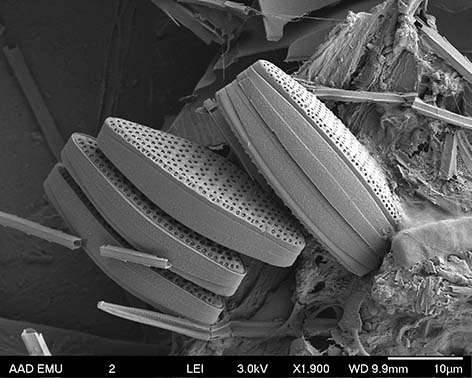IMOS is making phytoplankton data collected in the Southern Ocean available through the AODN Portal.
Phytoplankton play an important role in marine ecosystems, forming the base of pelagic food webs. The Southern Ocean is changing rapidly therefore tracking phytoplankton is fundamental to understanding and modelling ecosystem changes.
For example, warming around the western Antarctic Peninsula, coupled with thinning and reduced duration of the sea ice cover, has caused a shift in phytoplankton diversity and abundance from large, robust diatoms to smaller cells. This might have led to a shift from cold-water krill to warmer-water gelatinous salps, as salps can ingest far smaller phytoplankton than krill.
IMOS is currently analysing phytoplankton communities sampled along Continuous Plankton Recorder (CPR) transects in the Australian sector of the Southern Ocean. Any changes in species composition and abundance spatially, seasonally and inter-annually are recorded, and then the data are uploaded to the Australian Ocean Data Network (AODN) Portal.
The Australian Antarctic Division have deployed Continuous Plankton Recorders in the Southern Ocean for 30 years, offering an excellent long-term data set for researchers monitoring overall conditions in the Southern Ocean. IMOS is also contributing to the CSIRO image database for marine plankton and assisting with the construction of identification guides for the hundreds of taxa that have been found.
Along with the routine phytoplankton analysis of Southern Ocean CPR silks, we have been using Scanning Electron Microscopy (SEM) to identify problematic taxa. Overall, the SEM work provides excellent qualitative data – in ‘value adding’ to information already gleaned from light microscopy – but it is not a realistic method for quantitative analysis of CPR samples.
How to access the data:
The Southern Ocean Plankton Data are now available via the AODN Portal, enabling interested users to explore spatial and temporal patterns in the distribution of phytoplankton in the Southern Ocean. It is also easy to search for specific species or other taxa if researchers have a particular group that they are studying.
The direct links to the data are:
Please note:
These data collections currently only provide plankton abundances in “flat table” form (separate row for each taxon in each sample). However, these data are also available in analysis-ready (absences included, taxonomic changes managed), raw or binned (taxonomic group, genus, species) abundance products. All products are also available in bio-volume instead of abundance on request.
Currently these products can be obtained by contacting [email protected].
This news item was written by the Southern Ocean Plankton sub-Facility leader Dr Kerrie Swadling.
